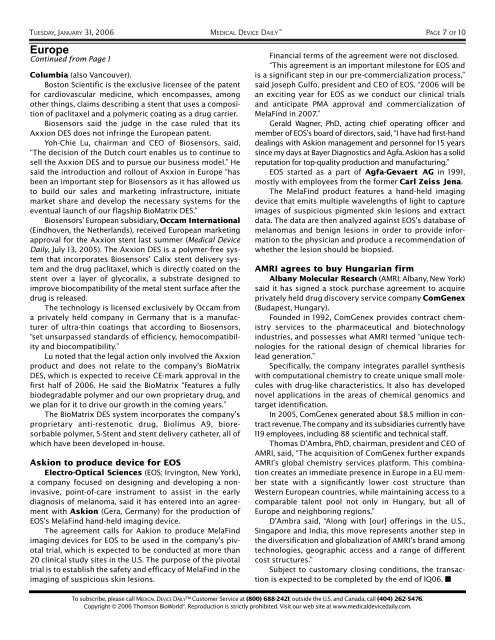INSIDE: - Medical Device Daily
INSIDE: - Medical Device Daily
INSIDE: - Medical Device Daily
Create successful ePaper yourself
Turn your PDF publications into a flip-book with our unique Google optimized e-Paper software.
TUESDAY, JANUARY 31, 2006 MEDICAL DEVICE DAILY PAGE 7 OF 10EuropeContinued from Page 1Columbia (also Vancouver).Boston Scientific is the exclusive licensee of the patentfor cardiovascular medicine, which encompasses, amongother things, claims describing a stent that uses a compositionof paclitaxel and a polymeric coating as a drug carrier.Biosensors said the judge in the case ruled that itsAxxion DES does not infringe the European patent.Yoh-Chie Lu, chairman and CEO of Biosensors, said,“The decision of the Dutch court enables us to continue tosell the Axxion DES and to pursue our business model.” Hesaid the introduction and rollout of Axxion in Europe “hasbeen an important step for Biosensors as it has allowed usto build our sales and marketing infrastructure, initiatemarket share and develop the necessary systems for theeventual launch of our flagship BioMatrix DES.”Biosensors’ European subsidiary, Occam International(Eindhoven, the Netherlands), received European marketingapproval for the Axxion stent last summer (<strong>Medical</strong> <strong>Device</strong><strong>Daily</strong>, July 13, 2005). The Axxion DES is a polymer-free systemthat incorporates Biosensors’ Calix stent delivery systemand the drug paclitaxel, which is directly coated on thestent over a layer of glycocalix, a substrate designed toimprove biocompatibility of the metal stent surface after thedrug is released.The technology is licensed exclusively by Occam froma privately held company in Germany that is a manufacturerof ultra-thin coatings that according to Biosensors,“set unsurpassed standards of efficiency, hemocompatibilityand biocompatibility.”Lu noted that the legal action only involved the Axxionproduct and does not relate to the company’s BioMatrixDES, which is expected to receive CE-mark approval in thefirst half of 2006. He said the BioMatrix “features a fullybiodegradable polymer and our own proprietary drug, andwe plan for it to drive our growth in the coming years.”The BioMatrix DES system incorporates the company’sproprietary anti-restenotic drug, Biolimus A9, bioresorbablepolymer, S-Stent and stent delivery catheter, all ofwhich have been developed in-house.Askion to produce device for EOSElectro-Optical Sciences (EOS; Irvington, New York),a company focused on designing and developing a noninvasive,point-of-care instrument to assist in the earlydiagnosis of melanoma, said it has entered into an agreementwith Askion (Gera, Germany) for the production ofEOS’s MelaFind hand-held imaging device.The agreement calls for Aakion to produce MelaFindimaging devices for EOS to be used in the company’s pivotaltrial, which is expected to be conducted at more than20 clinical study sites in the U.S. The purpose of the pivotaltrial is to establish the safety and efficacy of MelaFind in theimaging of suspicious skin lesions.Financial terms of the agreement were not disclosed.“This agreement is an important milestone for EOS andis a significant step in our pre-commercialization process,”said Joseph Gulfo, president and CEO of EOS. “2006 will bean exciting year for EOS as we conduct our clinical trialsand anticipate PMA approval and commercialization ofMelaFind in 2007.”Gerald Wagner, PhD, acting chief operating officer andmember of EOS’s board of directors, said, “I have had first-handdealings with Askion management and personnel for 15 yearssince my days at Bayer Diagnostics and Agfa. Askion has a solidreputation for top-quality production and manufacturing.”EOS started as a part of Agfa-Gevaert AG in 1991,mostly with employees from the former Carl Zeiss Jena.The MelaFind product features a hand-held imagingdevice that emits multiple wavelengths of light to captureimages of suspicious pigmented skin lesions and extractdata. The data are then analyzed against EOS’s database ofmelanomas and benign lesions in order to provide informationto the physician and produce a recommendation ofwhether the lesion should be biopsied.AMRI agrees to buy Hungarian firmAlbany Molecular Research (AMRI; Albany, New York)said it has signed a stock purchase agreement to acquireprivately held drug discovery service company ComGenex(Budapest, Hungary).Founded in 1992, ComGenex provides contract chemistryservices to the pharmaceutical and biotechnologyindustries, and possesses what AMRI termed “unique technologiesfor the rational design of chemical libraries forlead generation.”Specifically, the company integrates parallel synthesiswith computational chemistry to create unique small moleculeswith drug-like characteristics. It also has developednovel applications in the areas of chemical genomics andtarget identification.In 2005, ComGenex generated about $8.5 million in contractrevenue. The company and its subsidiaries currently have119 employees, including 88 scientific and technical staff.Thomas D’Ambra, PhD, chairman, president and CEO ofAMRI, said, “The acquisition of ComGenex further expandsAMRI’s global chemistry services platform. This combinationcreates an immediate presence in Europe in a EU memberstate with a significantly lower cost structure thanWestern European countries, while maintaining access to acomparable talent pool not only in Hungary, but all ofEurope and neighboring regions.”D’Ambra said, “Along with [our] offerings in the U.S.,Singapore and India, this move represents another step inthe diversification and globalization of AMRI’s brand amongtechnologies, geographic access and a range of differentcost structures.”Subject to customary closing conditions, the transactionis expected to be completed by the end of 1Q06. ■To subscribe, please call MEDICAL DEVICE DAILY Customer Service at (800) 688-2421; outside the U.S. and Canada, call (404) 262-5476.Copyright © 2006 Thomson BioWorld ® . Reproduction is strictly prohibited. Visit our web site at www.medicaldevicedaily.com.
















